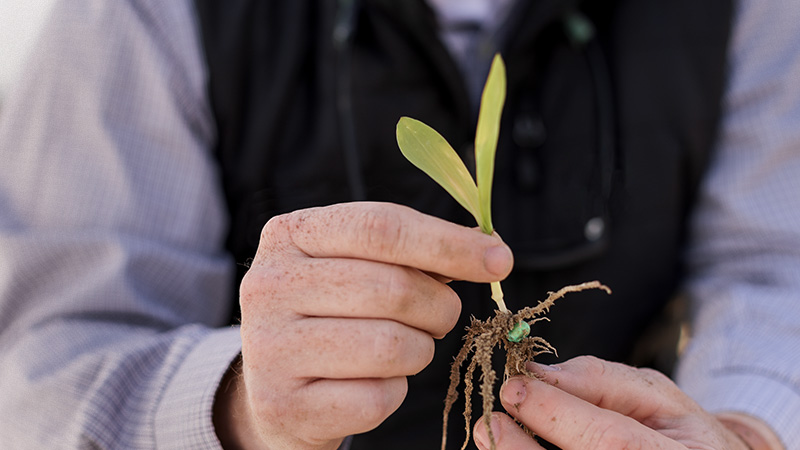Herbicides in 2019: Price Tag Shocks, Dicamba 3.0
Herbicide price hikes across the board are an inevitability for 2019, as retailers and the entire ag community deal with a couple of harsh realities: one, tariffs on imports from China and, two, fallout from the Chinese environmental clean-up that has gutted supply of some technical-grade and inert products.
Metribuzin is one example of a tough-to-get product as of late, according to industry people with whom we spoke.
Pesticides are among the $200 billion worth of Chinese products on which Washington has slapped a 10% tariff from Sept. 24. That duty will rise to 25% by Jan. 1.
Price increases of between 3% and 10% will affect the lion’s share, but some herbicides could soar as high as 40%.
“We are not wanting to do it, but we’re being forced, in some cases, to absorb some of those costs (from the Chinese plant shutdowns and tariffs),” Gail Stratman, Heartland Regional Technical Manager, FMC, tells CropLife® magazine. “We are very diligent and aware of the farm economy and what that’s doing to growers, and so we’re absorbing a lot of those costs. We’re definitely not passing on all of them that we could because we’re trying to keep our growers in mind and keep them profitable. If they’re not profitable, we don’t have much of a market anymore.”
Off-patent herbicide giant Albaugh also confirmed it would have no choice but to pass on the higher cost to its customers: “Though Albaugh has a very diverse supply chain based on production in the USA, Argentina, Mexico, Brazil, Europe, and India, on some products only China offers commercially or viable supply. In such cases, we are left with no alternative but to increase prices reflective of the higher tariffs.”
Willowood USA made a similar announcement. A letter to customers stated, in part: “Not every product in the Willowood USA portfolio will be subject to tariffs. In some cases, the tariffs will be imposed on technical that we import. In other cases, some of the intermediates used in our products will be subject to tariffs. This is a dynamic situation, and we will continue to monitor and communicate any changes to pricing, so as not to confuse the situation.”
Dicamba 3.0
Long-awaited news from EPA arrived Halloween night. Few were shocked it decided to renew the label for over-the-top use of dicamba, with additional restrictions in place, for two more years.

Rubischko
Ryan Rubischko, Bayer’s Dicamba Portfolio Lead, says, “XtendiMax is a highly effective, proven broadleaf weed control option that is delivering results for farmers, who have reported 95% weed control satisfaction over the last two seasons. This continued registration, based on an extensive review, keeps this much-needed weed control tool in the hands of growers.”
BASF chimed in with its reaction to the renewal: “The decision to extend registration of Engenia herbicide for an additional two years means that farmers will continue to have access to a critically needed tool to fight the expansion of herbicide-resistant weeds in their soybean and cotton fields. Farmers have told us that Engenia herbicide has given them the cleanest fields they have seen in years. Clean fields can lead to higher yields. That means farmers are able to grow more and sell more.”
Weed scientists, who’ve been quick to challenge EPA and manufacturers, disagree the label changes will translate to fewer drift cases. Dr. Bob Hartzler, Professor of Agronomy with Iowa State University, echoed his counterparts: “Unfortunately, I don’t think these new restrictions will have a significant impact on the problems we’ve seen the past two years. I was hoping for something similar to what Minnesota did in 2018, a date and temperature cutoff for dicamba applications on Xtend soybean.”
In 2018 Minnesota banned the application of dicamba on dicamba-tolerant soybeans after June 20 and when temperatures reached 85°F.

Johnson
Dr. Bill Johnson, Professor of Weed Science with Purdue University, was pleased to see EPA include a restriction on keeping the spray solution pH above 5 to reduce the chance of volatility.
“The positive thing is they’re admitting volatility is a contributor to off-site movement,” he says. “That’s much different than what they’ve been willing to admit to for the past two years.”
The challenge, of course, is that when glyphosate is tank-mixed with dicamba — as it often is for grass control — the pH is reduced.
This potential for greater volatility in that situation has some wondering if tank-mixing dicamba with Group 1 herbicides, like Select Max (Valent) or Fusilade DX (Syngenta), may be a better alternative to manage grass weeds and reduce the potential for off-target movement.
“I do not agree with that recommendation personally,” says Matt Geiger, Agronomy Service Representative with Syngenta, who fears important weeds could be missed without glyphosate in the tank. For instance, dicamba comes up short on control of certain broadleaf species, namely velvetleaf, eastern black nightshade, smartweed, and prickly sida.
“There also seems to be antagonism between dicamba and Group 1 herbicides for grass control because we were having a lot of problems controlling volunteer corn this year,” Geiger says. “So you’ve really got to have glyphosate in the tank.”
The most notable label change is the closing of the loophole that allowed literally anyone to spray dicamba so long as it was under the oversight of a certified applicator.

Payne
“The registrants want these (uncertified applicators) to demonstrate competency. You have to pass an exam, or in some states, once you pass you also have to take continuing education,” says Jean Payne, President of the Illinois Fertilizer and Chemical Association. “There are going to be a lot of farmers scrambling to get their hired people to test this winter or try to hire a commercial applicator.”
Payne says that despite the extra burden on retailers, the hope is that further testing and education will lead to better results. It’s just that, though: a hope.
“I would say we had a lot of competent education happen last year, and it still went awry. We ended up with 330 dicamba complaints in Illinois in 2018, (up from) 246 in 2017. That was after we trained 11,000 people,” she says. “Just because you test doesn’t mean you’re going to have a perfect application experience, and the commercial applicators can vouch for that.”
She adds that while Bayer makes frequent reference to decreased complaint calls it received to its hotline in 2018 even with expanded acreage, it doesn’t mean the overall number was down. It simply means growers chose to call their respective departments of ag this time around, she says. Total dicamba complaints for 2018 are still being evaluated as states’ investigations lag.
At the end of the day, Payne points out, there was no impact on yield from drift to speak of.
“It’s this paradigm of great soybean yields and yet (there is a) 400% increase in pesticide misuse,” she says. “How do you live in this world of such vast differences of perspective?”
There has been much grumbling, too, about logistical challenges around the new 57-foot buffer zone restriction, aimed at protecting endangered species. Illinois, for example, has at least 50 counties with endangered species, and many are in the southern part of the state that saw the most drift complaints.
“Those guys are going to have to leave a buffer on all four sides of the field. What do you do to control weeds in that buffer?” says Payne. More herbicide programs to manage, more headaches.
Thirty-four soybean- and cotton-producing states will now move to approve re-registrations. If it’s any signal of things to come, at press time Arkansas State Plant Board gave tentative approval for the in-crop use of dicamba next year with a cutoff date of June 15, but the matter will not be settled until the board’s Pesticide Committee meets on Nov. 26.
Rubischko says that Bayer opposes any additional restrictions that the states may impose, but he declined to say whether it would pursue legal action in the case of a potential ban — as it did with Arkansas last year. The company has done extensive research, including 1,200-plus trials and more in localized conditions, “to showcase why tools like XtendiMax can be used without additional further restrictions,” he says.
Bayer expects 60 million acres of Roundup Ready 2 Xtend soybeans and cotton with XtendFlex technology to be planted in 2019, up from 50 million in 2018. Its dicamba-tolerant soybeans comprised half of the total U.S. soybean acreage in 2018, according to the company.
Odds and Ends
While there is little new in terms of herbicide products beyond premixes, merger integrations mean that some duplicate products will be getting the boot in 2019. Dwight Lingenfelter, Extension Associate, Weed Science, Penn State University, checked off the major ones:
- Corteva will get rid of its Breakfree atrazine-based herbicides for use in corn.
- Corteva has discontinued manufacturing of Hornet, Instigate, and Prequel herbicides for use in field corn, but will continue to support them as they work their way to farmers and their fields throughout the next year or so
- Syngenta’s Beacon (primisulfuron-methyl) and Spirit (primisulfuron-methyl/prosulfuron) will be eliminated. “It’s not really a huge loss because nowadays we can make our own Spirit by using NorthStar and Peak,” Lingenfelter says.
For Corteva’s Enlist, the wait on China continues. Shawna Hubbard, Herbicides Product Manager, Enlist, says that while its E3 soybeans linger in the queue for import approval, Corteva is proceeding with training as if a 2019 launch is happening.
“The regulatory system that we’re dealing with is unpredictable,” she says. “We’ve done our part in submitting. I’m hopeful, but it’s hard to put dates on it. Our philosophy is don’t wait — put in the prep work now, so that we are prepared for full commercial launch.”
One concern weed scientists have is that, with Syngenta’s Calisto now having fallen off patent, more mesotrione on the market could mean greater potential for the formation of Group 27 HPPD resistance. “Because it’s a cheap and good herbicide, I think a lot more people are going to use it in their corn programs,” Lingenfelter says.
“What was a $15 product is now a $3 product. It happens a lot with these AIs, and I think it’s a key contributor to resistance,” FMC’s Stratman says.
Dr. Mark VanGessel, Professor and Extension Specialist with the University of Delaware, expects to see heavier seed banks out East thanks to heavy rains that drowned out spots in fields and had growers struggling to make timely applications in 2018.
But “with the way grain prices are and the way it’s been this season, farmers are thinking about their input cost for next year,” he says. ◗






